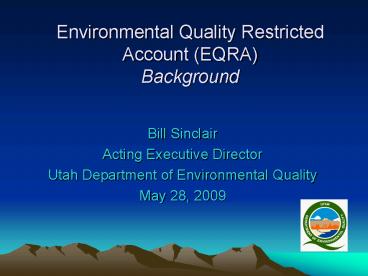Environmental Quality Restricted Account EQRA Background - PowerPoint PPT Presentation
1 / 19
Title:
Environmental Quality Restricted Account EQRA Background
Description:
Disposal fees originally established in 1985 to fund the Hazardous Waste program ... Incoming Funds - Fee Schedule. Year fee was last raised ... – PowerPoint PPT presentation
Number of Views:22
Avg rating:3.0/5.0
Title: Environmental Quality Restricted Account EQRA Background
1
Environmental Quality Restricted Account
(EQRA)Background
- Bill Sinclair
- Acting Executive Director
- Utah Department of Environmental Quality
- May 28, 2009
2
EQRA - Background
- Disposal fees originally established in 1985 to
fund the Hazardous Waste program - First fee was on hazardous waste at 6/ton
- EQRA codified in UCA 19-1-108 in 1996
- EQRA provides revenue for regulation of solid,
hazardous, and radioactive waste - Funded through disposal fees paid by operators of
commercial solid, hazardous, radioactive waste
facilities and municipal solid waste landfills - Amount of waste varies month to month, year to
year, waste by waste, making revenues vary
3
Principles of EQRACurrent State
- Until recently, has provided a sufficient source
of funding to account for fluctuations in waste
volumes - Covers entire waste management program
- Fees are not dedicated to a specific function or
site - Scope of waste facility operations and oversight
does not decrease with reduced volumes coming
into facilities
4
Revenues
Incoming Funds - Fee Schedule Year fee was last
raised
Hazardous Waste Fees 28/ton 1993 unless treated
which is 14/ton 1997
Generator Site Access Permit Annual Fees 2,500
per generator 7,500 for brokers 2009
Uranium Mill Monthly Fees 5,833 (standby)
8,333 (operating) 2009
Radioactive Waste Fees 0.15/cubic feet and
1/curie for LLW or 28/ton Mixed 2001
Commercial Solid Waste Facility
Fees 2.50/ton 2006
Environmental Quality Restricted Account
Municipal Solid Waste Facility Annual
Fee Average 0.13/ton 2003
Solid Waste Construction and Demolition Waste
Facility Fee 2.50/ton 2006
Interest Income
PCB Fees (applies to both radioactive and
hazardous waste facilities 4.75/ton 1993
Incoming Funds- Statutory Year fee was last raised
5
Disbursements
Funds have been used for DWQ, DAQ, HLNW, and GF 1
or more times
General Fund Revenue 400,000/year
Host county receives 10 of hazardous waste fees
Hazardous Substances Mitigation Fund
OPTIONAL Goal 400,000/year
Dept of Public Safety OPTIONAL 200,000/year
Environmental Quality Restricted Account
Division of Radiation Control Program Budget
DEQ Executive Directors Office Budget
Division of Solid and Hazardous Waste Program
Budget
6
(No Transcript)
7
Why are we in this situation?
8
EQRA Status without further Action
9
EQRA 10 Year Average Revenues Contribution
10
EQRA 10 Year Average Disbursements
11
(No Transcript)
12
EQRA Immediate Need for FY10 (July 1, 2009 - June
30, 2010)
- Will need to address the shortfall projected to
occur - DEQ will be submitting a General Fund
supplemental appropriation request as part of the
budgeting process - Will need support of the Governor, Legislature,
and Stakeholders
13
Options for stabilizing EQRA into the future
(FY11 and beyond)
14
Option 1 - Maintain Current Fee Structure
Annual General Fund Supplemental Appropriation
- Advantages
- Industry continues to pay based on rate-based
fees (fee/ton or fee/cubic foot) - Disadvantages
- Requires a General Fund appropriation which is
contrary to the user fee concept of paying for
services - DEQ revenue varies based on volume disposed
- Competing for General Fund monies is a difficult
process
15
Option 2 - Increase Current Fee Structure Rates
- Advantages
- Raises required revenue
- No need for General Fund supplemental
appropriation - Maintains user fee concept of paying for services
- Disadvantages
- Industry pays more
- May impact volume or tonnage disposed
- DEQ revenue varies based on volume disposed
16
Option 3 - Develop A Flat Fee Structure
- Advantages
- Industry is certain of fees owed to DEQ
- DEQ has guaranteed revenue stream without
fluctuations due to changes in volumes disposed - No General Fund appropriations needed
- Maintains user fee concept of paying for services
- During high volume years, industry may pay less
than Option 2
17
Option 3 continued - Develop A Flat Fee Structure
- Disadvantages
- Industry may pay more
- May impact volume or tonnage disposed
18
Consequences of inaction
- Reduction in Force within DEQ (DSHW, EDO and DRC)
- Jeopardizes authorization, federal grants
- Less timely issuance of permits, modifications,
technical assistance, plan reviews - Less oversight, including independent sampling
- Reduction or elimination of important programs
- Recycling
- E-waste
- Staff Training
- Small business compliance assistance
- Corrective action, clean ups
- Redevelopment
- Inability to fund Superfund match
19
Where do we go from here?
- Stakeholders assistance needed to evaluate these
options. - Are there other options we need to consider?
- Timeframe for deliberations
- June 2009 - next Stakeholder meeting to discuss
the options - July 2009 - Stakeholder meeting to develop
consensus on path forward - August/September 2009 - Develop strategy for path
forward (including potential legislation)

